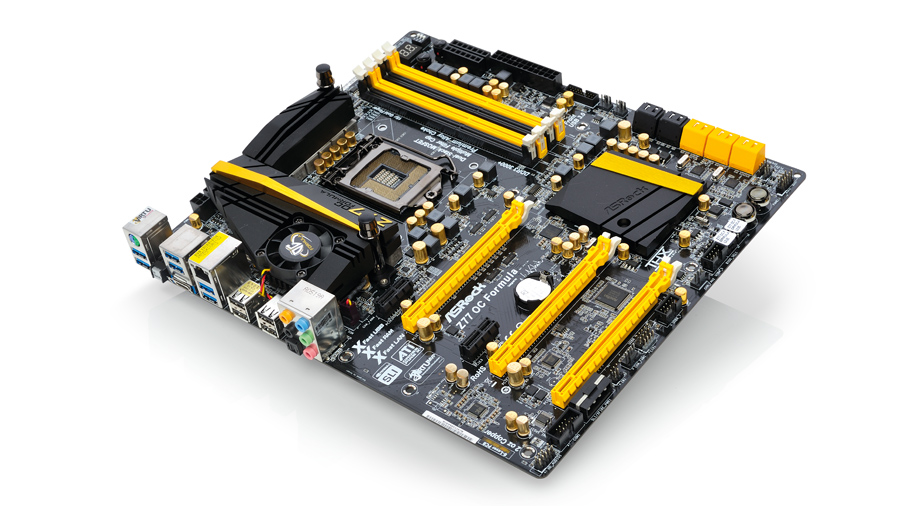TechRadar Verdict
Pros
- +
Good OC options
- +
Build quality
- +
Full remit of connections
- +
Water cooling options
Cons
- -
Takes effort to get a good OC
Why you can trust TechRadar
Motherboards are dull. Decide the specs you need, compare on price and, maybe, take branding and reputation into account, and pull trigger. It's that simple.
Not so fast. In a market that's become a bit stale, feisty upstart ASRock may just have produced something special. Certainly, the combination of specification and price looks the most promising we've seen in a long time.
Okay, this is not a cheap board. But lest you forget, high-end motherboards from the likes of Asus and Gigabyte cost up to and beyond £300. So, let's get a feel for what the ASRock Z77 OC Formula has to offer, starting with the electricals.
First up, there are the 12+4 power phases and high-end chokes and MOSFETs. Then there's the eight-layer PCB. And not just any old eight layers, but fully four of them composed of two-ounce copper. According to ASRock, the competition makes do with a couple of two-ounce layers, the poor, deluded fools.
Next up, ASRock has used three different types of capacitors, designed to soak up low, mid and high-frequency noise. It's all about giving the CPU the cleanest possible power supply and in turn maximising overclocking headroom, which is this board's chief raison d'etre.
On that subject, the main chipset cooling is hewn from some seriously hefty chunks of alloy and has a small fan for active cooling. Oh, it's plumbed for water cooling, too, giving you plenty of options.
ASRock has also bundled some high-end heat paste for the CPU. It's Gelid OC Extreme and it won't freeze if you use liquid nitrogen. Pointless? Perhaps, but it hints at a broader attention to detail. So we're not knocking it.
There's software to help you achieve maximum clocks, too, including access to uber fine grained 400-step controls for the CPU voltage. We'd tell you all about the extra thick gold on the CPU and PCI Express connectors and pins or the 11 thermal sensors around the motherboard - but you get the idea.
Instead, digest this final little touch that trumps them all. You get a set of plastic stands that plug into the board's screw holes. Stick 'em all in and you have yourself an instant test bench with sufficient spacing to plug in a video card. Nice.
As for the broader spec, that includes a metric tonne of USB 3.0 ports, support for three-way CrossFire and more. Like we said, this thing really does promise to be something a bit special.
So what about that overclocking performance? Unfortunately, this board isn't an overclocking king out of the box. If you want to achieve a quick and dirty overclock, Asus's Z77 Sabertooth continues to rule. That's despite some initial promising custom profiles ASRock includes in its slick and polished BIOS interface.
Benchmarks
CPU video encoding performance
X264 v3.0: Frames oer second: Bigger is better
ASROCK Z77 OC FORMULA: 34
ASUS SABERTOOTH Z77: 34
CPU gaming performance
Just Cause 2: Frames oer second: Bigger is better
ASROCK Z77 OC FORMULA: 103
ASUS SABERTOOTH Z77: 106
Maximum overclock
Core i7-3770K: Megahertz: Bigger is better
ASROCK Z77 OC FORMULA: 4.7
ASUS SABERTOOTH Z77: 4.9
Ultimately, we think you'll achieve higher clocks with more ease on the Sabertooth. No doubt the features ASRock has included will be a boon to hardcore overclockers using exotic cooling solutions, such as liquid nitrogen. Indeed, records have been set with the Z77 OC Formula.
But back in mainstream overclocking land, that's of little value. As an alternative to a £300 Asus RoG board, ASRock is undoubtedly onto something. But for us, Asus' Sabertooth still rules the roost.
Technology and cars. Increasingly the twain shall meet. Which is handy, because Jeremy (Twitter) is addicted to both. Long-time tech journalist, former editor of iCar magazine and incumbent car guru for T3 magazine, Jeremy reckons in-car technology is about to go thermonuclear. No, not exploding cars. That would be silly. And dangerous. But rather an explosive period of unprecedented innovation. Enjoy the ride.
Most Popular





